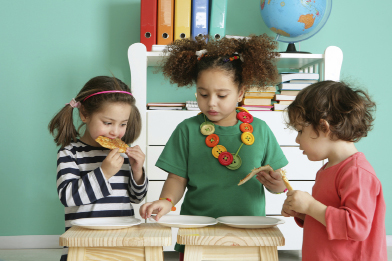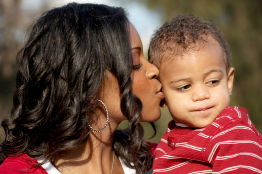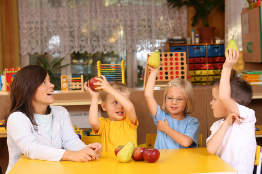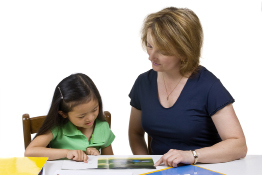Session 1
| Site: | MoodleHUB.ca 🍁 |
| Course: | Early Learning and Child Care 30 Modules |
| Book: | Session 1 |
| Printed by: | Guest user |
| Date: | Thursday, 18 December 2025, 10:32 AM |
Description
Created by IMSreader
1. Session 1
Session 1: Nurturing Through Physical Routines
Introduction

© Ekaterina Monakhova/iStockphoto
routine: an event that occurs every day at about the same time
Routines provide a safe, stable, and consistent framework for the day. Physical routines are those regularly reoccurring times organized to meet children’s physical needs. They include the activities of eating, resting or sleeping, diapering, and toileting.
This session will look at the physical routines that are part of the child’s day in a child care setting. Caregivers will provide opportunities to build a child’s trust, independence, and initiative during daily routines as a way to promote self-esteem.
The session also highlights the importance of smooth and effective transitions between various parts of the child’s day.
1.1. Get Focused
Session 1: Nurturing Through Physical Routines
Getting Focused Activity: I Wonder What It Feels Like
Children learn a lot about trust, relationships, and themselves through daily routine activities guided by an adult. The child care provider’s feelings strongly affect these interactions because the provider manages, guides, and interacts with children. Reflecting on the feelings of both the child and the child care provider may help providers plan routines in a thoughtful and sensitive manner.
Have you ever wondered what a child feels like in the following situations:
- having to line up to go to the bathroom
- having to lie quietly when feeling full of energy
- being asked to put away a spaceship just before landing on the moon
- being told to finish what is left on the plate when having a tummy that feels all tied up in knots
Directions
Step 1: Review the situations.
Step 2: Think of similar situations from your childhood.
Step 3: Briefly describe at least two of your childhood situations. Include in your description how you felt in each situation and explain why you think you felt that way.
Step 4: Explain how you would have wanted the adult(s) in each of the situations to respond to you.
Step 5: Participate in a class discussion where you share at least one situation.
 Checking In
Checking In
Contact your teacher for instructions about participating in the discussion.
1.2. Inquiry 1
Session 1: Nurturing Through Physical Routines
Inquiry 1: Nurturing Through Physical Routines—Is It Routine?
To provide you with an overview of nurturing physical routines, watch the “Nurturing Through Physical Routines” video clip. You may require a username and password to access this video. Contact your teacher for this information.
nurturing: what child care providers do when they conscientiously try to meet children’s social and emotional needs
Daily Care Routines
A large portion of the child’s day in child care involves interacting with child care providers and other children in daily routines.
- Arrival and departure. This is the manner that children are greeted, the way that child care providers respond to children’s reactions to separating from their parents, and the way that children are supported in the transition from home to play at the centre. All of these interactions can have a tremendous impact on the child’s well-being.
- Meal and snack time. Mealtime can be stressful for child care providers and for children, or it can be a part of the day that is eagerly anticipated as full of opportunities for enjoyment and learning.
- Nap time. Children need rest in order to grow and develop. This can be a challenge in group care, but careful planning, the right environment, and respect for children’s needs will help.
- Diapering, toileting, and dressing. The way that a child care provider relates to the child during these interactions can help children feel positive about themselves, their bodies, and their ability to be independent.
Each of these routines will be explored in more depth in this session.
During routine care, a child’s basic need for food, rest, and security are met. The familiarity and predictability of routines add to a child’s sense of security.
Routines provide an opportunity for one-to-one interaction with infants and older children, while also providing meaningful opportunities for children to learn. Routines are most successful when the developmental level (what they can and cannot do or understand) of the children is taken into account.
The cultural and family backgrounds of child care providers influence the way providers manage and respond to routines. It is critical for child care providers to remember that routines must be carried out in ways respectful of children.
Arrival and Departure of Children

© Junial Enterprises/shutterstock
Child care providers should consider the following practices:
- Greet each child and parent individually when they arrive and say goodbye when they leave. When parents and/or guardians feel better about leaving the child, the child usually feels better too.
- Watch for signs that a child needs more support with separation from parents. Signs may include extended crying, a lack of appetite, or a need to sleep more than normal. Discuss any concerns with your supervisor and the parents and/or guardians.
- Respect relationships within the family. Some children may need help leaving the parent or family member when they depart from the centre. Parents or family members can often help the child cope with arrival and departure.
- “Build bridges” between home and the centre. Display pictures and engage in conversations about each others’ lives. Talking about the child’s home will usually make the child feel better.
- Plan experiences for arrival and departure times so that at least one child care provider is available to spend this time with parents and children. Children should be able to easily join or leave an experience. Special markers, paper, puzzles, and tabletop toys are examples of materials that can be used during arrivals and departures.
- As often as possible, share with parents interesting and positive things their children have done. For example, “Marco ate all his lunch today. He really seemed to enjoy the spaghetti and meat sauce.” Or “Renada and Sarafina had such fun with the blocks today. They used all the blocks in their creation.”
- Be warm and welcoming with the parents and/or guardians and other family members. It is important for family members to know that child care providers are interested in them as individuals.
-
Prepare children for departures so that leaving isn’t a sudden interruption. For example, the child care provider might say, “Mummy will be coming soon. Then we will put the book back on the shelf.”
ritual: an activity done consistently every time
- Provide consistency of rituals.
Developmental Reminders
Follow these reminders:
- Strong, secure relationships are required for infants to gain a sense of trust in order to “attach” to a significant other person or persons.
- Stranger anxiety appears at about six months of age.
- Separation anxiety usually appears at about nine months. (Remember that children will know that Mommy and Daddy exist, but won’t understand why they can’t be with them.)
- At about one year, babies and toddlers can identify pictures of loved ones.
- Preschoolers can express separation feelings in words. (“I miss Mommy.”)
- Preschoolers may develop fears related to separation. (“Mummy might forget and won’t come and pick me up.”)
- Separation anxiety is normal throughout childhood years.
- Children who have experienced many separations may find each new one more difficult.
It is important to always think about the children’s developmental abilities in order to understand how they may respond to arrival and departure.
Eating Together: A Positive Experience
Developmental Reminders
Follow these developmental reminders:
- For young babies, the feeding experience is a crucial moment for close contact and interaction with an adult. They learn basic trust and security by having their needs met.
- As babies grow, mealtime becomes a way to learn about the world around them, as much of their learning is through their senses. Therefore, the colours, tastes, and textures of food become very important.
- As toddlers gain independence (autonomy), mealtime is an important opportunity to learn to eat by themselves (with a bit of tactful help by their caregiver).
- For preschoolers, mealtime becomes an opportunity to socialize with other children, learn manners, share ideas, and enjoy eating.
Children attending child care centres eat lunch and two snacks daily (morning and afternoon). Programs generally serve a breakfast or snack and provide a mid-afternoon snack. There are many variations in how food is served, who supplies the food, and when food is eaten. Food is necessary for existence, but concerns with food go far beyond nutrition. Food becomes a way of marking special events, an expression of concern or care, and an expression of one’s culture.
Eating together at the child care centre is important for the following reasons:
- People eat to meet the physical need for food. Nutritious food not only satisfies hunger but is required for body growth and maintenance. Approximately 70 percent of a child’s nutritional needs may be met while the child is at the child care centre.
- Eating habits are established during the early years. Many of these habits persist throughout a lifetime.
- Eating together serves many social purposes. Infants begin to develop trust during feeding times, whereas older children learn independence during this time.
- Children’s language and intellectual development can be fostered while they are eating together.
- Eating provides a time when family and cultural practices can be shared. Respect for differences should be modelled and encouraged by the child care providers.
1.3. Page 2
Session 1: Nurturing Through Physical Routines
Responsibilities of the Child Care Provider

© matka_Wariatka/shutterstock
Child care providers need to ensure they carry out the following responsibilities:
- Children are served nutritious food in accordance with Canada’s Food Guide. Check out the nutritious suggestions offered on Canada’s Food Guide website. This site includes all kinds of interesting information and activities for both young and old!
- Foods of questionable proportions and textures are served in appropriate sizes to eliminate the possibility of choking.
- Providers need to wash their own hands and help children make sure their hands are thoroughly washed before preparing, serving, or eating food. All food must be eaten in a clean environment.
- To ensure cleanliness, wash hands for appropriately 60 seconds. Did you know that singing the Happy Birthday song twice takes about 60 seconds?
- Encourage conversation among children (and that includes the child care providers).
- Hold babies under six months old when feeding them a bottle because this develops the infant’s ability to trust and to feel secure.
- Sit at the table with children during meals and snacks.
- Support children’s independence and initiative. For example, encourage children to help themselves from a serving bowl and to put their dirty dishes away.
- Use mealtime as an opportunity for learning appropriate social behaviour. Children learn table manners through watching the caregiver’s behaviour and through gentle encouragement. Be sure to model good manners and encourage children to say “please” and “thank you.”
- Do not use food as a reward or a punishment. Food is a human right—it is completely inappropriate to be used as either a punishment or a reward.
- Encourage children to try new foods but never force them.
- Ensure that children have enough time to finish their meals and that they are eating in the appropriately designated area(s).
- Respect cultural differences relating to food and ensure children’s dietary restrictions are met in respectful ways.
- For tips on encouraging healthy habits, read the information included in “Children’s Healthy Eating.” The document is a valuable tool in understanding how to help children make sound food choices. This document can also be found in the Toolkit.
Nap Time

© Thomas M Perkins/shutterstock
As a child care provider, you should aim to follow these guidelines:
- Establish and follow a routine that supports children moving from eating lunch to toileting to rest time quietly, calmly, and without hurrying.
- Try to find ways to help children feel secure at rest time. For example, spend a few minutes with each child or allow each child to take a favourite sleep toy or blanket to the cot or mat.
- Use a variety of quieting techniques to help children settle. For example, rub children’s backs, sit quietly beside them, or read them a story.
- Recognize children’s need for sleep varies. Centres should allow children who need less sleep to play quietly after a period of rest. For example, they can play with books and puzzles on the cot or in a quiet area away from sleeping children.
- Wake up children gradually and gently. Interesting activities should be available for children as they wake. Recognize that some children take a long time to wake up.
- Infants should be encouraged to sleep as their individual needs dictate. They should always have clean, dry diapers before sleeping.
Developmental Reminders
Follow these developmental reminders:
- Infants can require two to three naps per day starting at four months of age.
- At about ten months, one afternoon nap is often enough.
- All children have different needs in terms of napping. Most children continue to take naps until the age of three, some children still nap until age five, and others stop at age two.
- Toddlers may have difficulty going to sleep if there is too much activity going on around them.
Toileting Practices

© AVAVA/shutterstock
As a child care provider, you should commit to the following:
- Always wash your hands before and after diaper changing, and clean the changing surface after each use. These practices help to stop the spread of contagious diseases.
- Diapers should be changed as soon as possible when they are soiled or wet because doing so prevents diaper rash and also helps children to learn to trust as they come to recognize others will, and do, respond to their needs.
- Begin to toilet train a toddler when the toddler shows that she or he is ready. Toilet learning is more successful when parents and child care providers work together. Remember that all indicators must occur regularly to show a child is developmentally ready for toilet training.
- Remind preschoolers to go to the toilet before sleep, outdoor play, and other times when they will be away from a bathroom.
- Respond to toileting accidents in a sensitive and respectful manner. Accidents are common, especially among younger preschoolers. Encourage good hygiene practices. Even toddlers can begin to practise health-related toileting practices, such as washing their hands and flushing toilets.
- In most child care centres, boys and girls use the bathrooms at the same time. Some children may be uncomfortable with this openness. Respect children’s need for privacy. Children start displaying a need for privacy around the age of four.
Developmental Reminders
Follow these developmental reminders:
- Some babies are very fussy when they are being changed and do not like things pulled over their heads. Other babies may enjoy having their diapers changed and welcome the attention they receive.
- Babies may like to roll, twist and turn, and pull off their socks. They should never be left alone on a changing table.
- Between 12 and 18 months, some toddlers like to stand when being diapered. They become interested in their private parts, and like to “help” getting dressed.
- From 18 months onward, many toddlers want to do things by themselves and get frustrated when they can’t.
- Readiness for toilet training is individual. It should only be attempted when all of the following indicators are happening regularly:
- The toddler is dry for at least two hours at a time.
- The toddler has regular bowel movements.
- The toddler shows signs of knowing when diapers are wet or soiled.
- The toddler shows interest in the toilet.
- The toddler can hold and wait after indicating a need.
- The toddler is not in a highly “no-no” period.
- The toddler can verbally express the need to go to the washroom (e.g., “pee,” “poo”).
- The toddler can take off and put on pants on his or her own.
- Before toileting becomes a routine, young children may go through a period when they are especially interested in the acts of urinating and bowel movements. They like flushing toilets, watching others on the toilet, and talking about toileting.
- Even though sometimes young preschoolers need to go to the bathroom, they do not want to leave their play. If you see them wiggling or straining, remind them to go to the bathroom. It is normal for “accidents” to happen in toddlers and preschoolers, and these incidents should be treated calmly and with respect—avoiding shame at all costs.
 Checking My Understanding
Checking My Understanding
Is It Appropriate Practice?
Indicate whether each of the practices in the Is It Appropriate Practice? activity is appropriate. You will be given immediate feedback as to whether or not your answer is correct.
1.4. Learning Activity 1
Session 1: Nurturing Through Physical Routines
Learning Activity 1: The Importance of Routine
Children’s success with learning routines increases when parents and/or guardians, other family members, and child care providers work together. It is critical that routines in a child care centre are developmentally appropriate and are carried out in ways respectful of families’ cultural backgrounds and practices.
This is a three-part learning activity. In the first part, you will develop a form for acquiring information from parents and/or guardians about the practices included in the routines they have with their young children. You will also acquire this information from a few parents and/or guardians.
In the second part, you will design and develop a brochure or small poster focusing on one daily routine that could be included on a child care centre’s family bulletin board. Note: It is not expected to actually include the brochure or poster on a child care centre’s family bulletin board. Before posting or distributed any information in a child care centre, be sure to check with the director.
In the third part, you will assess and submit your work.
It is a good idea to read the assessment criteria prior to starting this learning activity and to review it periodically as you work on the learning activity. See the Student Rubric for Learning Activity 1: The Importance of Routine.
Part 1: Learning from Families
Directions
Develop a form that includes opportunities for parents and/or guardians to share the following:
- the beliefs and values they have about napping and/or bedtime, meals and/or snacks, and toileting
- practices they follow in each of the routines
Be sure your form includes the following items:
- There is a section for parents and/or guardians to include their contact information.
- There is an explanation of why you are gathering this information and how you will be using it.
- Remember, the confidentiality of this information is critical and, therefore, it is important that you do not share it with others besides your teacher. You may wish to review the information included in Protocol for Working With Children and Child Care Providers. This information is also in the Toolkit.
- Once you have developed the form, check in with your teacher. Discuss with your teacher the clarity, appropriateness, and respectfulness of your language and questions.
- If necessary, make required revisions based on your teacher’s response.
- Using the form, acquire information from a minimum of two parents and/or guardians (from different families) who have a child or children between the ages of newborn to five years. The parents and/or guardians do not have to have children in a child care facility. They should not be parents of children at the child care facility where you are completing other components of this course.
Part 2: Sharing with Families
Directions
Design and develop a brochure or small poster focused on one of the daily routines (napping/resting, eating, or toileting) that could be included on a child care centre’s family bulletin board. The purpose of your brochure or poster is to inform family members of the practices followed in a child care centre. It is not to inform family members of what practices they should follow in their homes.
The information provided in your brochure or poster should be
- developmentally appropriate
- respectful of the beliefs and values of the parents and/or guardians from whom you gathered information
- represented through both visuals as well as print
Part 3: Assessing and Submitting Your Work
Directions
Step 1: Self-assess your brochure or poster using the Student Rubric for Learning Activity 1: The Importance of Routine.
Step 2: Submit the three parts of this assignment to your course folder:
- information forms from parents and/or guardians
- a brochure or a small poster
- self-assessment rubric
1.5. Inquiry 2
Session 1: Nurturing Through Physical Routines
Inquiry 2: Transition Time in Child Care
transition time: the time children spend moving from one part of the day to another
Transition time is the time children spend moving from one part of the day to another. One example is when children go from snack time to outdoor play.
It is estimated that children spend 20–35 percent of their day in transitions at child care. Transition is such an important part of the child’s day, yet it is often unplanned. You have to think of transitions as a part of the day—a portion that provides opportunities for children to learn.
Children can learn to co-operate, be considerate of each other, and classify and match during cleanup. A beautifully planned day can fall apart if transitions are not planned. Discipline problems are reduced when transitions are planned properly. As well, children’s well-being is promoted when they feel they have some control over what they are doing and when they are doing it, rather than being rushed from activity to activity.
Important: Do you recall learning about transition times in CCS3110? It may be helpful to review the content provided, and your work, in this earlier course.

© matka_Wariatka/iStockphoto
Child care providers can help children move smoothly and unhurriedly from one activity of the day to another.
Here are some helpful strategies:
- Always make children aware of upcoming transitions (usually five minutes before the transition). For example, tell them “You have time for a few more slides, then we will go inside for lunch.”
- Make transitions fun by using cues or signals, such as a song, a chant, or a special drumbeat, to signal that a transition is coming.
- Give clear, simple directions.
- Allow ample time for the change to occur.
- If children do not have a choice, speak the directions so that the children know this. For example, say “It’s almost clean-up time” instead of “Do you want to clean up now?”
- Act calmly.
- Explore ways to avoid situations where all the children move together as a large group.
- Use finger plays, simple songs, and games with the children at those times when waiting cannot be avoided.
1.6. Learning Activity 2
Session 1: Nurturing Through Physical Routines
Learning Activity 2: Observing Routines
In this learning activity you will have an opportunity to learn about routines by observing in the child care centre.
Note: If you are not usually at the child care centre during arrival or departure, make arrangements so you will be able to go during these times. This activity may require that you go to the child care centre at a different time of day than usual or on a different day of the week.
Note: You may need to make observations a couple of times in the child care centre so that you will be able to see arriving or departing, nap time, meal and/or snack time, and toileting.
Directions
Step 1: While observing one or more child care provider’s interactions with children, parents and/or guardians, and family members in the child care centre, complete Learning Activity 2: Observing Routines.
Step 2: Choose one of these routines to focus on: arriving or departing, nap time, meal or snack time, or toileting.
- In the first column, respond to the question: How were transitions to the routine supported?
- In the second column, respond to the question: What practices were included in the routine?
- In the third column, respond to the question: What changes, if any, were made to the environment?
- In the fourth column, respond to the question: Other than attending to the children’s basic needs, what other responsibilities did the child care provider(s) have during this time?
- In the fifth column, respond to the question: How did routine promote children’s development in a safe and nurturing way?
Step 3: Discuss your observations with a child care provider. Are there any alternative strategies that could be incorporated into the routine to have the strongest impact for the child? Add discussion items to the table.
Step 4: Save your completed learning activity in your course folder.
 Checking In
Checking In
Update your Course Completion Checklist. Discuss your progress with your teacher.
1.7. Session 1 Summary
Session 1: Nurturing Through Physical Routines
Session Summary
Important: The quiz may contain questions beyond points highlighted in this summary. Be sure to review the session thoroughly.
Review Session 1 to prepare for writing the quiz. As you review, note the sections that connect with the following points:
- Working in a child care program involves a number of physical routines: eating, resting, sleeping, and toileting. Managed well, routines can nurture and support young children. Managed poorly, any routine can be difficult for both the child and child care provider.
- This session suggests constructive practices for each routine. In general, these practices stress respecting children’s needs as well as promoting age-appropriate development. Planning and creative problem solving should be used to avoid conflict and to maintain the children’s positive self-esteem.
- With routines such as eating and toileting, health and safety issues are as important as the child’s social and psychological needs.
- Transitions are times spent moving from one part of the day to the next and are often stressful for the children and the caregivers. The transitions of arriving at and leaving the centre are particularly important. All transitions should be handled in a smooth, thoughtful, and unhurried manner.
- Children gain comfort from positively managed routines and transitions. This smooth, positive management communicates that people care about their emotional and physical health, and this is what nurturing is all about.
Session Quiz
 Checking In
Checking In
It is now time to fill in your Course Completion Checklist if you haven’t already. This checklist can be found in the Toolkit and is used to keep track of your progress. Print or save a copy in your course folder, and ensure it is updated regularly. If there are concerns, communicate with your teacher about them.
Contact your teacher to decide together when and where you will complete the Session 1 Quiz.